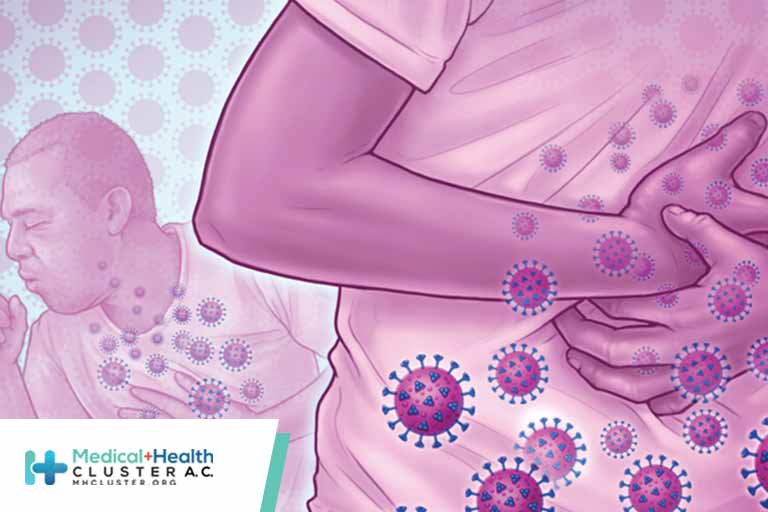En atención a la creciente preocupación sobre la confianza en...
Leer más
SARS-CoV-2 RNA Can Persist in Stool Months After Respiratory Tract Clears Virus

SARS-CoV-2, or at least pieces of it, sticks around longer in some infected individuals than respiratory sample testing would suggest, a recent study found.
After respiratory samples tested negative, a small proportion of the 113 study participants continued to shed SARS-CoV-2 RNA in their feces—about 4% of them for at least 7 months—and those people were more likely to report ongoing gastrointestinal (GI) symptoms, researchers reported in the journal Med.
The findings provide more evidence that SARS-CoV-2 infects the gut as well as the lungs and could help explain why some people with “long COVID” have persistent abdominal pain, nausea, and other GI symptoms, according to the authors.
The Poop
It’s no secret that infected people shed SARS-CoV-2 through feces. Among patients with moderate to severe COVID-19, studies have detected SARS-CoV-2 RNA in about 40% to 85% of fecal samples.
However, the authors of the new study wrote, less is known about fecal shedding of SARS-CoV-2 RNA in people with mild to moderate disease, even though they represent about 81% of those who are infected. Most studies of mild to moderate cases have been cross-sectional or followed up patients for a relatively short period after diagnosis. The few studies that have investigated longitudinal fecal samples found that fecal shedding can persist longer than shedding in respiratory samples.
“I guess we had a little bit of a hint that the clearance rate was different, but I was definitely surprised,” senior author Ami Bhatt, MD, PhD, an associate professor of medicine and of genetics at Stanford University, said in an interview.
In her new study, fecal SARS-CoV-2 RNA was detected in about half of the participants within the first week after a polymerase chain reaction–confirmed diagnosis of COVID-19. At 4 months, no participants were still shedding viral particles from the respiratory tract, but 12.7% continued to shed SARS-CoV-2 RNA in feces. At 7 months, 3.8% were still shedding SARS-CoV-2 in feces.
Gut Punch
Besides collecting stool samples, the researchers administered questionnaires about participants’ symptoms daily for their first 4 weeks in the study. At appointments on days 120, 210, and 300, the scientists asked participants about their symptoms during the previous week.
Abdominal pain, nausea, and vomiting were associated with fecal shedding of SARS-CoV-2 RNA, but diarrhea was not—possibly a chance finding because so few people reported experiencing diarrhea, Bhatt said.
Some individuals who continued to shed SARS-CoV-2 RNA in their stool were asymptomatic, she noted. “The presence of ongoing shedding is not perfectly correlated with the presence of symptoms.”
Unanswered Questions
-
Why would SARS-CoV-2 linger in the gut longer than in the respiratory tract? “I wonder if it’s a less-robust and vigorous immune response in the gut vs the respiratory system,” Bhatt speculated. Because the gut is home to trillions of bacteria, maybe it’s more tolerant of SARS-CoV-2, she explained.
-
Is live, infectious SARS-CoV-2 commonly shed in stool? Bhatt and her coauthors cited a February 2021 review article that discussed the possibility of fecal-oral transmission if live SARS-CoV-2 were shed in stool. For safety and practical reasons, Bhatt’s team provided participants with kits that could inactivate live virus to collect stool samples at home and mail them back. Some other studies have reported isolating infectious SARS-CoV-2 from feces, whereas others have reported being unable to, Bhatt and her coauthors noted.
-
Does SARS-CoV-2 directly infect gut tissue? “In conjunction with recent related findings, this work presents compelling evidence of SARS-CoV-2 infection in the gastrointestinal tract,” but confirming that would have required intestinal biopsies, the authors wrote about their study. However, laboratory research has shown that SARS-CoV-2 can infect intestinal cells, and recent small studies based on autopsies or prior biopsies have found evidence of direct intestinal infection, according to Bhatt and her coauthors.
-
How might persistent fecal shedding change how wastewater epidemiology interprets findings? “There is high value in following SARS-CoV-2 in wastewater,” Bhatt said. “I don’t think that our work suggests that wastewater-based epidemiology should not happen or is deeply flawed.” But she and her coauthors noted, if SARS-CoV-2 transmission occurs largely or entirely through respiratory secretions, “the continued presence of fecal viral RNA in wastewater from a prolonged GI infection may be mistakenly interpreted as evidence of the prevalence of infectious individuals in a community.”
-
Might the SARS-CoV-2 RNA found in feces at the later time points represent reinfection, not persistent infection? Waning immunity can predispose people to reinfection or, as in the case of tuberculosis, reactivation of latent infection, Bhatt said, adding, “I don’t know [whether] that’s what’s happening here.”
-
Could persistent SARS-CoV-2 infection of the gut help explain postacute sequelae of SARS-CoV-2, commonly known as long COVID? Bhatt said her team plans to continue tracking symptoms in study participants for a total of 2 years. Meanwhile the National Institutes of Health’s RECOVER (Researching COVID to Enhance Recovery) Initiative, a multicenter study of the long-term effects of COVID-19, which plans to enroll 15 000 adults with SARS-CoV-2 infection and 2680 without it, will collect stool as well as urine and saliva samples from participants.
Créditos: Comité científico Covid




